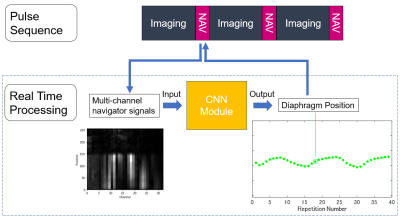Yuji Iwadate1, Atsushi Nozaki1, Shigeo Okuda2, Tetsuya Wakayama1, and Masahiro Jinzaki2
1Global MR Applications and Workflow, GE Healthcare Japan, Hino, Japan, 2Department of Radiology, Keio University School of Medicine, Tokyo, Japan
1Global MR Applications and Workflow, GE Healthcare Japan, Hino, Japan, 2Department of Radiology, Keio University School of Medicine, Tokyo, Japan
We propose a deep learning-based respiratory navigator
(DLnav) technique which uses a convolutional neuronal network. DLnav resulted
in good synchronization with actual respiratory motion and reduced
motion-induced blurring.

FIG. 3: Respiratory waveforms and signal-to-noise ratio of
respiratory-like frequencies (SNRR) calculated with the conventional
(green) and DLnav methods (yellow). a, b: Respiratory waveforms
overlapped on the navigator signals with the tracker at the normal position (a)
and the tracker on the heart (b). c: SNRR with the tracker of the
normal position (Normal) and the tracker positioned on the heart (Heart). DLnav
showed a good synchronization
with the actual respiratory motion even
at the bad tracker position on the heart.
